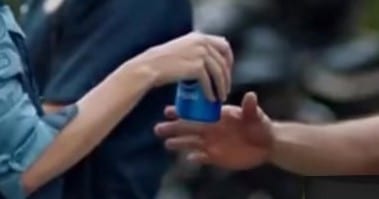
Sometimes advertising catches a viewer’s attention and speaks to important needs of the present. In April 2017, Pepsi released what it thought was just such a timely commercial starring Kendall Jenner on YouTube. The commercial showed Jenner leaving a photo shoot to join a protest that appeared to be innocuous. After taking part of the protest that consisted of a racially diverse group of individuals with signs reading, “Join the Conversation,” Jenner walked up to a line of stoic police officers who formed a wall in front of the protesters. She handed one of them a freshly-opened can of Pepsi. The officer carefully took a sip of the drink and then smiled. The crowd of protesters began to cheer and celebrate. The advertisement concluded with the Pepsi logo and the words “Live for Now” displayed beneath it.
The commercial proved controversial. Some saw in this video the possibility of unity in an America caught in the throes of anti-police protests. Those who lauded the commercial believed it was Pepsi’s well-intentioned attempt to promoting diversity and unity among viewers. The ad incorporated a diverse group of actors composed of various races, genders, and possibly religions representing the protesters. An anonymous actor involved with the commercial stated that Pepsi tried to “depict a message of unity.” He also said that “The commercial had hip-hop dancers and we were all together as humans. I think they tried to show the meaning that people from every country can be together.”
But many viewers did not appreciate the advertisement. Those who were offended by the commercial believed that the video was tone-deaf and that it co-opted serious protests that were occurring across the U.S. in order to sell a soft drink. Many people expressed their frustration towards Jenner online. The video’s images brought to mind the Black Lives Matter protests that were featured in most news sources at the time. For instance, the shot of Jenner giving a Pepsi can to the officer resembled the powerful photo of Ieshia Evans, a black woman protesting the death of Alton Sterling, drifting unflinchingly and effortlessly toward approaching heavily-armed police officers. Others argued that the commercial oversimplified and trivialized the progress and struggle of the civil rights movement in America. Those who disagreed with the commercial saw Pepsi as asserting the idea that the simple gesture of giving a police officer a sugary beverage would put an end to police brutality and racial animosity. Berenice King, the daughter of Martin Luther King Jr., tweeted a photo of her father with the following caption: “If only Daddy would have known about the power of #Pepsi.”
Pepsi eventually capitulated to the rising public pressure. After removing the ad from online sources, they released the following statement: “Pepsi was trying to project a global message of unity, peace and understanding. Clearly we missed the mark, and we apologize. We did not intend to make light of any serious issue. We are removing the content and halting any further rollout. We also apologize for putting Kendall Jenner in this position.”
Discussion Questions:
- Did Pepsi do anything ethically problematic in producing the ad in question? Why? What values are in conflict in this case?
- How much do the intentions of advertising companies matter in judging the appropriateness of their advertisements?
- Was Pepsi’s response to the controversy over the advertisement adequate?
- Should an advertiser’s creative freedom be limited by social issues of the day? If so, how should advertisers guide themselves in creating edgy but ethical advertisements?
- Would there be an ethical way to use protest iconography in a Pepsi ad? Explain how you might do so, if you think it is possible. How does this use differ from the advertisement that Pepsi released?
Further Information:
Hirsh, Sophie. “An Actor From THAT Pepsi Commercial Says Most Actors Weren’t Aware It Would Be Problematic.” Teen Vogue. 30 May 2017. Available at: https://www.teenvogue.com/story/pepsi-commercial-backlash
Pinsker, Joe. “How on Earth Does an Ad Like Pepsi’s Get Approved?” The Atlantic, 8 Apr. 2017. Available at: https://www.theatlantic.com/business/archive/2017/04/pepsi-kendall-jenner-ad-how/522423/
Schultz, E.J., and Ann-Christine Diaz. “Pepsi Is Pulling Its Widely Mocked Kendall Jenner Ad.” Ad Age, 5 Apr. 2017. Available at: http://adage.com/article/cmo-strategy/pepsi-pulling-widely-mocked-kendall-jenner-ad/308575/
Victor, Daniel. “Pepsi Pulls Ad Accused of Trivializing Black Lives Matter.” The New York Times, 5 Apr. 2017. Available at: https://www.nytimes.com/2017/04/05/business/kendall-jenner-pepsi-ad.html
Wong, Julia Carrie. “Pepsi Pulls Kendall Jenner Ad Ridiculed for Co-opting Protest Movements.” The Guardian, 06 Apr. 2017. Available at: https://www.theguardian.com/media/2017/apr/05/pepsi-kendall-jenner-pepsi-apology-ad-protest
Authors:
Urub Khawaja & Scott R. Stroud, Ph.D.
Media Ethics Initiative
Center for Media Engagement
University of Texas at Austin
July 22, 2018
Image: Screen Capture of Pepsi Ad / Modified
This case study can be used in unmodified PDF form for classroom or educational settings. For use in publications such as textbooks, readers, and other works, please contact the Center for Media Engagement.
Ethics Case Study © 2018 by Center for Media Engagement is licensed under CC BY-NC-SA 4.0



